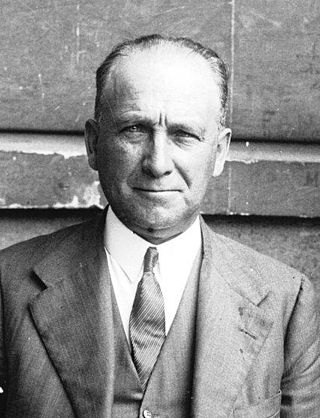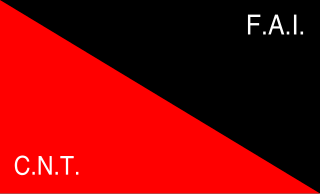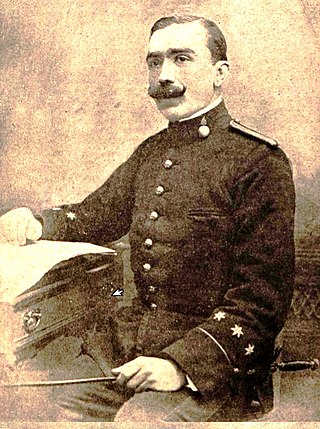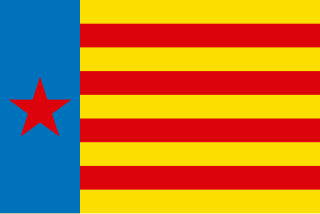
The Spanish Socialist Workers' Party is a social-democratic political party in Spain. The PSOE has been in government longer than any other political party in modern democratic Spain: from 1982 to 1996 under Felipe González, 2004 to 2011 under José Luis Rodríguez Zapatero, and since 2018 under Pedro Sánchez.

Francisco Largo Caballero was a Spanish politician and trade unionist, who served as the Prime Minister of the Second Spanish Republic during the Spanish Civil War. He was one of the historic leaders of the Spanish Socialist Workers' Party (PSOE) and of the Workers' General Union (UGT). Although he entered into politics as a moderate leftist, he took a more radical turn after the 1933 general election in which the conservative CEDA party won the majority and began to advocate for a socialist revolution.

The Popular Front was an electoral alliance and pact formed in January 1936 to contest that year's general election by various left-wing political organizations during the Second Spanish Republic. The alliance was led by Manuel Azaña. In Catalonia and the modern-day Valencian Community, the coalition was known as the Front of the Lefts.
The May Days, sometimes also called May Events, refer to a series of clashes between 3 and 8 May 1937 during which factions on the Republican side of the Spanish Civil War engaged one another in street battles in various parts of Catalonia, centered on the city of Barcelona.
The Unión General de Trabajadores is a major Spanish trade union, historically affiliated with the Spanish Socialist Workers' Party (PSOE).

Indalecio Prieto Tuero was a Spanish politician, a minister and one of the leading figures of the Spanish Socialist Workers' Party (PSOE) in the years before and during the Second Spanish Republic.

Julián Besteiro Fernández was a Spanish socialist politician, elected to the Cortes Generales and in 1931 as Speaker of the Constituent Cortes of the Spanish Republic. He also was elected several times to the town council of Madrid. During the same period, he was a university professor of philosophy and logic, and dean of the department at the University of Madrid. He was imprisoned after the Civil War and died in jail.

Revolutionary Catalonia was the period in which the autonomous region of Catalonia in northeast Spain was controlled or largely influenced by various anarchist, communist, and socialist trade unions, parties, and militias of the Spanish Civil War era. Although the constitutional Catalan institution of self-government, the Generalitat of Catalonia, remained in power and even took control of most of the competences of the Spanish central government in its territory, the trade unions were de facto in command of most of the economy and military forces, which includes the Confederación Nacional del Trabajo which was the dominant labor union at the time and the closely associated Federación Anarquista Ibérica. The Unión General de Trabajadores, the POUM and the Unified Socialist Party of Catalonia were also prominent.

The Confederación Nacional del Trabajo is a Spanish confederation of anarcho-syndicalist labor unions, which was long affiliated with the International Workers' Association (AIT). When working with the latter group it was also known as CNT-AIT. Historically, the CNT has also been affiliated with the Federación Anarquista Ibérica ; thus, it has also been referred to as the CNT-FAI. Throughout its history, it has played a major role in the Spanish labor movement.
The crisis of 1917 is the name that Spanish historians have given to the series of events that took place in the summer of 1917 in Spain. In particular, three simultaneous challenges threatened the government and the system of the Restoration: a military movement, a political movement and a social movement. These events coincided with a number of critical international events that same year. However, in world history this period is not typically referred to as a crisis, and the term is instead reserved for specific issues relating to World War I, such as the conscription crisis in Canada and the crisis of naval construction in the United States. Spain remained neutral throughout the conflict.

Vicente Uribe Galdeano was a Spanish metalworker and politician who became a member of the executive of the Communist Party of Spain (PCE). He served as Minister of Agriculture during the Spanish Civil War (1936–1939) for the Republican faction. He went into exile in Mexico during World War II (1939–1945), then lived in France and Czechoslovakia after the war. He was disgraced in 1956 during the post-Stalinist power struggle.

Óscar Pérez Solís was a Spanish artillery officer, engineer, journalist and politician. He became attracted to left-wing causes, and left the army in 1912. He joined the Spanish Socialist Workers' Party and was its candidate in several general elections. In 1921 he was one of the founders of the Communist Party of Spain, and became secretary-general of the party. He converted to Catholicism during a period in prison in 1925–27. After being released he disavowed his left-wing beliefs and became associated with the right-wing Falangists.

Juan López Sánchez was a Spanish construction worker, anarchist and member of the Confederación Nacional del Trabajo, and one of the founders of the Federación Sindicalista Libertaria. During the Spanish Civil War (1936–1939) he was Minister of Commerce under Francisco Largo Caballero. After the war he spent several years in exile before returning to Spain where he lived without persecution and participated in the "vertical" trade union movement authorized by the dictatorship of General Francisco Franco.

Anastasio de Gracia Villarrubia was a Spanish bricklayer, trade union leader and socialist politician. He became a national delegate during the Second Spanish Republic (1931–1939). During the Spanish Civil War (1936–1939) he was a minister in the government of Francisco Largo Caballero from September 1936 to May 1937. After the defeat of the Republicans he went into exile in Mexico, where he lived for more than forty years.

Fernando de los Ríos Urruti was a Spanish professor of Political Law and Socialist politician who was in turn Minister of Justice, Minister of Education and Foreign Minister between 1931 and 1933 in the early years of the Second Spanish Republic. During the Spanish Civil War (1936–1939) he was Spanish Ambassador to France and then to the United States.
Women in Unión General de Trabajadores (UGT) in Francoist Spain played important roles in the union dating back to the Second Republic period, even as their specific needs like maternity leave, childcare provisions and equal pay were subverted for the improvement of better overall working conditions. Women UGT leaders in the Civil War period included María Lacrampe and Claudina García Perez.

The Popular Executive Committee of Valencia was a revolutionary autonomous entity created on July 22, to confront the Spanish coup of July 1936 which started the Spanish Civil War. It was made up of the political forces of the Popular Front and the trade union forces of the National Confederation of Labor and General Union of Workers. Based in Valencia, it covered most of Valencia province and part of Castellón and Alicante.

Daniel Anguiano Mangado (1882–1963) was a Spanish trade unionist and politician. As member of the Spanish Socialist Workers' Party (PSOE) and the Unión General de Trabajadores (UGT), he assumed a leading role in the 1917 general strike. An endorser of the PSOE's adhesion to the Third International, he left the party to form the Spanish Communist Workers' Party (PCOE) in 1921.
Treintism was a political movement within libertarian socialism in the Second Spanish Republic. Initially a faction within the National Confederation of Labor (CNT), the Treintists were, after the publication of the Manifesto of the Thirty in September 1931, expelled from the CNT over the course of the years 1931 and 1932 and formed the Syndicalist Party in 1932. The Treintists and the labor unions associated with them, the Opposition Syndicates, rejoined the CNT in 1936. The movement fell into political irrelevance with the victory of the Nationalist forces of Francisco Franco in the Spanish Civil War.
The labor movement in Spain began in Catalonia in the 1830s and 1840s, although it was during the Democratic Sexenio when it was really born with the founding of the Spanish Regional Federation of the First International (FRE-AIT) at the Workers' Congress of Barcelona in 1870. During the Restoration, the two major Spanish trade union organizations were founded, the socialist Unión General de Trabajadores and the anarcho-syndicalist Confederación Nacional del Trabajo, with the latter predominating until the Second Spanish Republic. CNT and UGT were the protagonists of the social revolution that took place in the Republican zone during the first months of the Spanish Civil War. During Franco's dictatorship, the two historical centers were harshly repressed until they practically disappeared. In the final stage of Franco's regime, a new organization called Workers' Commissions emerged, which together with the reconstituted UGT, will be the two majority unions from the beginning of the new democratic period until the present day.
















